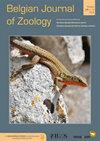Spatial and seasonal variation in reproductive indices of the clupeids Limnothrissa miodon and Stolothrissa tanganicae in the Congolese waters of northern Lake Tanganyika
IF 1.1
4区 生物学
Q2 ZOOLOGY
引用次数: 5
Abstract
Knowledge on the reproductive biology of the endemic clupeids Limnothrissa miodon and Stolothrissa tanganicae, two main target species of the pelagic fisheries of Lake Tanganyika, is constrained by fragmented monitoring activities. Here, we investigate the nursing areas of L. miodon, the timing of reproductive activities of littoral and pelagic L. miodon, and the timing of reproductive activities of pelagic S. tanganicae in the Congolese waters of the northern end of Lake Tanganyika (Bujumbura sub-basin). Nursing areas were determined year-round (2009–2010) based on the presence of clupeid larvae at two sandy and two stony beaches. The gonadosomatic index (GSI) and the proportion of fish having ripe gonads were used to study variation in reproductive indices in space (littoral vs. pelagic zones) during one year (2013–2014), as well as in time (dry vs. rainy season) during three years (2013–2016). Larvae of L. miodon were more frequently encountered on sandy than on stony beaches. Mature L. miodon females were more abundant in the littoral than in the pelagic zone, while the proportion of mature males in both habitats was similar. Irregular, low amplitude peaks could be distinguished in the GSI and proportion of mature males and females, but averages only differed between the dry and the rainy season in males. In contrast, GSI and proportions of mature males and females in S. tanganicae were higher in the dry season than in the rainy season. The reproductive effort of males and females of S. tanganicae and littoral L. miodon, but not pelagic L. miodon, was strongly synchronized. Interestingly, reproductive investment was also synchronised between pelagic male L. miodon, and pelagic S. tanganicae. Our time series strongly supports the view that L. miodon reproduces year-round in the littoral zone, while reproduction in S. tanganicae is seasonal. For fisheries management, we recommend year-round protection of sandy beaches, which are the main breeding grounds for L. miodon.坦噶尼喀湖北部刚果(金)水域米齿绒螯蟹和坦噶尼察绒螯蟹繁殖指数的空间和季节变化
坦噶尼喀湖远洋渔业的两个主要目标物种,地方性clupeids Limnothrisa miodon和Stolothrisa tanganicae的生殖生物学知识受到零散监测活动的限制。在这里,我们调查了在坦噶尼喀湖北端(布琼布拉次盆地)的刚果水域中,米氏乳杆菌的饲养区、沿岸和远洋米氏乳球菌繁殖活动的时间以及远洋唐氏乳杆菌繁殖活动的时机。全年(2009-2010年)根据两个沙质和两个石质海滩上的Clupied幼虫的存在情况确定了护理区。性腺体指数(GSI)和性腺成熟的鱼类比例用于研究一年(2013-2014)期间空间(沿海区与远洋区)以及三年(2013-2016)期间时间(旱季与雨季)生殖指数的变化。在沙质海滩上比在石质海滩上更容易发现L.miodon的幼虫。成熟的L.miodon雌性在沿海地区比在远洋地区更为丰富,而两个栖息地的成熟雄性比例相似。在GSI和成熟雄性和雌性的比例中可以区分出不规则的低振幅峰值,但雄性的平均值仅在旱季和雨季不同。与此相反,唐蛙科的GSI和成熟雄性和雌性的比例在旱季高于雨季。唐氏小蠊和沿岸小蠊的雄性和雌性的繁殖努力是强烈同步的,而远洋小蠊则不是。有趣的是,繁殖投资在远洋雄性L.miodon和远洋S.tanganicae之间也是同步的。我们的时间序列有力地支持了这样一种观点,即L.miodon在沿海地区全年繁殖,而S.tanganicae的繁殖是季节性的。在渔业管理方面,我们建议全年保护沙滩,因为沙滩是水貂的主要繁殖地。
本文章由计算机程序翻译,如有差异,请以英文原文为准。
求助全文
约1分钟内获得全文
求助全文
来源期刊

Belgian Journal of Zoology
生物-动物学
CiteScore
1.90
自引率
0.00%
发文量
10
审稿时长
>12 weeks
期刊介绍:
The Belgian Journal of Zoology is an open access journal publishing high-quality research papers in English that are original, of broad interest and hypothesis-driven. Manuscripts on all aspects of zoology are considered, including anatomy, behaviour, developmental biology, ecology, evolution, genetics, genomics and physiology. Manuscripts on veterinary topics are outside of the journal’s scope. The Belgian Journal of Zoology also welcomes reviews, especially from complex or poorly understood research fields in zoology. The Belgian Journal of Zoology does no longer publish purely taxonomic papers. Surveys and reports on novel or invasive animal species for Belgium are considered only if sufficient new biological or biogeographic information is included.
 求助内容:
求助内容: 应助结果提醒方式:
应助结果提醒方式:


